White gold in the Porkies
In the Upper Peninsula, a wilderness park rewards those who love snow.
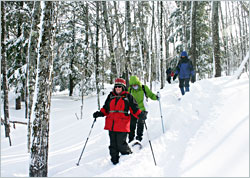
© Beth Gauper
On the far end of Michigan's Upper Peninsula, Porcupine Mountains Wilderness State Park always rewards those who make the effort to get there.
When 12 of us did, steering through a blizzard in cars heaped with snowshoes and skis, our prize was even more snow-falling every day from the sky, swirling in stiff winds and piled high on the earth.
Luckily, we retain a child-like love of the white stuff. So we had ourselves a snowpalooza, gliding through snow-draped forests, making snow angels and taking countless photos of snow mushrooms, snow arches and snow slabs on Lake Superior.
And the snowshoeing? The best of our lives.
A hundred miles of trails crisscross the 94 square miles of the park, whose ridges rise 1,000 feet above 23 miles of Lake Superior shoreline.
Only the eastern corner of the park is open in winter, because it's a pain to keep roads plowed. Park employees got stuck three times just plowing the short drive to Kaug Wudjoo Lodge, the former park manager's residence where we stayed.
We envied the snowmobilers who were whizzing along the groomed Lake of the Clouds Trail to the magnificent overlook that's the main tourist draw in summer. In winter, it's accessible only by sled or a very long hike.
Other than that, we were happy to explore on foot.
On the first afternoon, we snowshoed from our door to the little marina on Union Bay and along Lake Superior, where winds had pushed ice and snow against the shore and arranged slabs that, in one spot, formed a perfect whale.
For blazing trail through the woods, we strapped on big Greenland and Ojibwe snowshoes that gave us the loft we needed for the thigh-deep snow.
We were awestruck by the lavish quantities of powder and the beauty it created just by falling. One favorite photo op: square dollops of snow that sit atop stumps and look like giant mushrooms.
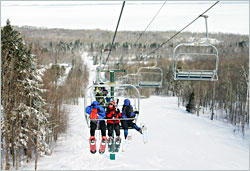
© Beth Gauper
On Saturday, we joined a free snowshoe hike. The park also has a downhill area run by ski-industry students at Gogebic Community College in Ironwood, so we snowshoed over there on the Nonesuch Trail to meet park naturalist Bob Wild.
In the snowshoe hut near the chalet, he gave those of us with traditional snowshoes more modern ones with metal crampons, for traction descending the ski hill.
Then we got on the chairlift and rose into the air, craning our necks to see the panoramic view of Lake Superior behind us.
From the top, it was all down, down down. We bounded along the Hidden Valley alpine run and then into deep forest, to a warming house on the Log Camp cross-country trail, where we passed other guests on their way to the rustic Union River Cabin.
A spur took us to East Vista, where we gazed out at the lake and along the shore as it starts to form the Keweenaw Peninsula.
At least three of us asked Wild about the big "lake" just beyond the park's eastern boundary. He said it actually is a sea of tailings from the White Pine mine, which extracted nearly 2 million metric tons of copper from 1955 to 1995 and has just been purchased for continued mining.
There were mines in the park, too, and the Cuyahoga run and Nonesuch trail are named for them.
While the copper left, the trees stayed. Loggers were eager to get to the area, known as the "Great Uncut," but in 1945 it was made a state park, preserving a stand of old-growth forest that is is considered the biggest and best of its kind east of the Mississippi.
Bears are plentiful in the park, and Wild told us of one that cross-country skiers had found hibernating nearby-right in the middle of a trail.
When the bear got sleepy at the beginning of winter, Wild said, it simply dug a hole and flopped down. Machine groomers had been driving over it all winter, but no one spotted it until the skiers came by in late winter and saw it underfoot. Male bears, Wild added, aren't very picky about where they sleep.
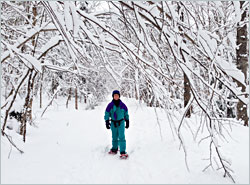
© Beth Gauper
Caribou were native to the area, but deer moved in only after mining created open spaces. They spend the winter under a canopy of hemlocks near the lake, off the Deer Yard ski trail, trying to avoid the park's wolves.
We headed to that area Saturday evening for the weekly lantern-lit ski on the 1.6-kilometer Superior Loop, just west of the two Union Bay yurts and our lodge.
From the road, we spotted the first of a string of kerosene lanterns and followed them through the woods to a roaring bonfire tended by Wild, who told us to help ourselves to hot chocolate in the warming hut.
On Sunday, we had a choice: More snowshoeing, downhill skiing or cross-country skiing on trails newly tracked after a groomer was fixed? A friend advocated for downhill skiing: "How often do you get to ski on powder like this in the Midwest?"
But the wind was blowing again, so I joined one of two snowshoe groups heading for the waterfalls at the junction of the Union and Little Union rivers.
Half of us went over the hill via chairlift, following the first part of Bob Wild's route, and the rest of us took the River Trail on the east edge of the park.
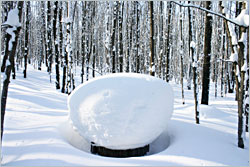
© Beth Gauper
When we reached the ravine where the Union River meets the Little Union River, we were awestruck anew: snow-coated branches formed a canopy over the trail, creating what a friend dubbed "Narnia."
It was the way you want winter to be: quiet, serene and drop-dead gorgeous. We passed three young men, dragging their stuff back to their car from the Little Union River yurt, and we were glad we didn't have to leave yet.
A lone skier from Land O' Lakes, Wis., came by and told us he had rented the yurt for the next weekend with a Kentucky friend and was checking out the route.
On the way back, we saw he had left us a message in the snow: "Grouse!" with an arrow pointing to a hole where the bird had emerged from its snow roost.
Meanwhile, the other snowshoe group had used a compass to make a beeline to the Union River, where, like us, they hadn't found any waterfalls but had exulted in the Narnia-like wonderland.
They didn't straggle in until nearly 6 p.m., and I marveled that we all had spent so much time in the cold and wind instead of our comfortable 1950 lodge.
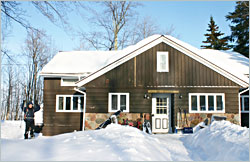
© Beth Gauper
Bearing the area's original name — Kaug Wudjoo, Ojibwe for "place of the crouching porcupine" — the two-story log lodge has four bedrooms, two bathrooms, a fieldstone fireplace and as much wood as you feel like burning.
A picture window provides a view of Lake Superior that is a bit monochromatic in winter but still worth staring at from one of the rocking chairs.
We hung our wet hats and mittens on a 10-point buck in the living room and crowded around a trestle table to eat our meals, prepared in the fully equipped kitchen.
Still, a lodge is a lodge. There's only one Porkies, and we wanted to spend as much time in it as we could.
It does take a while to get to the park, and you do have to bring everything you need, because the nearest town is 13 miles way.
But once you're there, you don't want to leave.
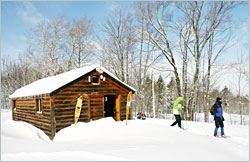
© Beth Gauper
Trip Tips: Winter in the Porcupine Mountains
Getting there: It's an hour north of Ironwood on the Wisconsin-Michigan border. From U.S. 2 in Wakefield, drive north on Michigan 28 and 64. The main entrance to the park is just west of Silver City. When you get there, you'll be on Eastern Standard Time.
The closest town is Ontonagon, 13 miles east. The best place to get groceries is the Super One in Ironwood, on the east end of town.
Annual events: February, Midwest Telefest, with telemarking demos and tours, and Winter Carnival.
When to go: The park has bountiful snow from November into April, then beautiful waterfalls on the Union and Presque Isle rivers.
For summer and fall activities, see Afoot in the Porkies.
Candlelight skiing: From the last week of January through February, the park naturalist hosts a lantern-lit ski every Saturday evening on the one-mile Superior Loop, dependent on conditions.
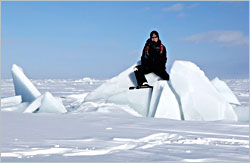
© Lauren Gagner
Snowshoeing: From 1-3:30 p.m. Saturdays from the last week of January through February, the naturalist leads a free 3-mile snowshoe hike that starts with a ride up the ski hill. The chairlift is included on the naturalist hike and costs $7 at other times.
Snowshoes are available to borrow (first-come, first-served). To register, call naturalist Katie Urban at 906-885-5206.
There's excellent snowshoeing throughout the park, with rentals at the ski hill.
Cross-country skiing: There are 42 kilometers of cross-country trails that connect to the alpine runs.
Alpine skiing: The park includes a downhill ski area with 42 runs and a vertical drop of 787 feet. The longest run is 1 1/8 miles.
The ski area rents downhill and also cross-country skis.
Accommodations: In the park, the modern Kaug Wudjoo Lodge sleeps up to 12 in four bedrooms, one with a queen, one with a queen and a single, one with three singles and one with two bunk beds. There are two baths, but only one has a shower.
From December through April, it's $200 per night, with a four-night minimum. It can be reserved up to a year in advance at Michigan DNR Reservations, 800-447-2757.
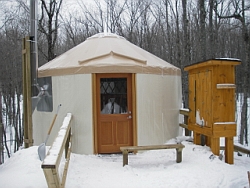
© Debra Gagner
Three of the park's 19 wood-heated rustic cabins, $68, are open in winter. One is on the lakeshore near the Deer Yard Trail and one on the Union River off the River Trail.
Cookware and tableware are provided, but guests need to bring a cookstove.
Four yurts are open year-round and can be reached only by trail. Two of the yurts are on the lake, just west of the Union Bay campground. One is near the Union River, a three-mile hike on the River Trail, and the Lost Creek yurt is a seven-mile hike or ski over hilly terrain.
The yurts do not have electricity or running water. Wood is provided. They sleep four, and the cost is $68.
There's also a new tiny house in Union Bay campground that sleeps four and has a kitchen, electricity and heat.
Reserve cabins, yurts and tiny house up to six months in advance at Michigan DNR Reservations, 800-447-2757.
Mountain View Lodges, just outside the eastern entrance to the park, are two-bedroom cabins with wood-burning fireplaces, VCRs, cable TV, well-equipped kitchens, screened porches and sofa sleepers. Four cabins are open to pets and one is wheelchair-accessible.
Three miles east of the park entrance, the Americinn in Silver City has an indoor pool, restaurant, free hot breakfast and pet-friendly rooms.
Information: Porcupine Mountains Wilderness State Park, 906-885-5275. Porcupine Mountains tourism, 906-885-5399.